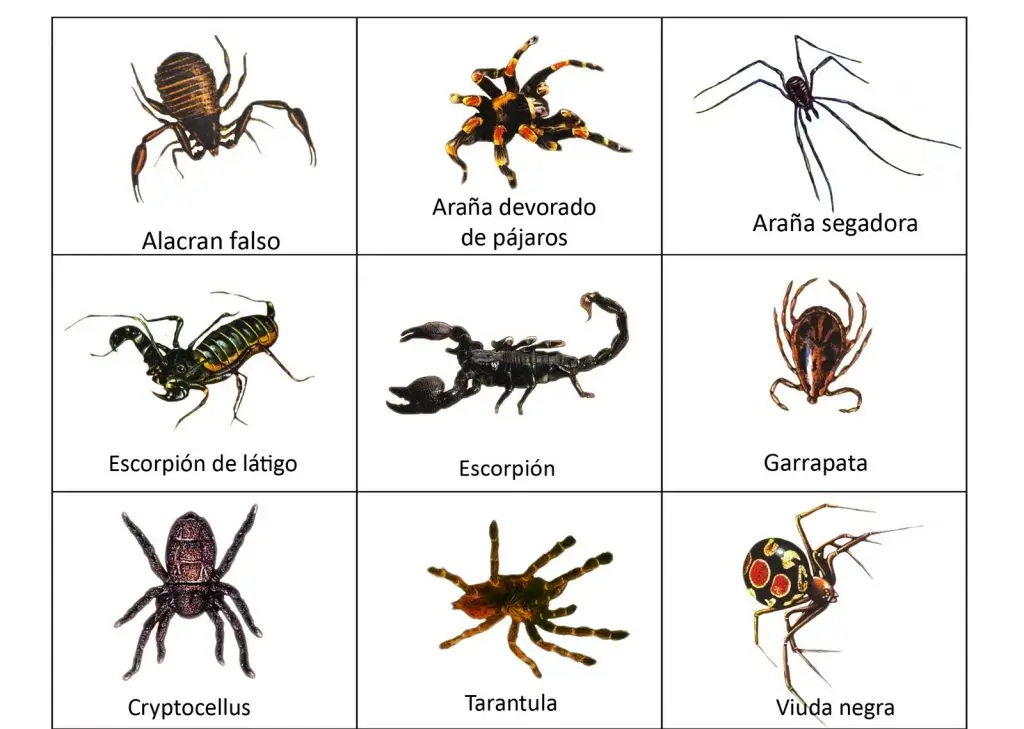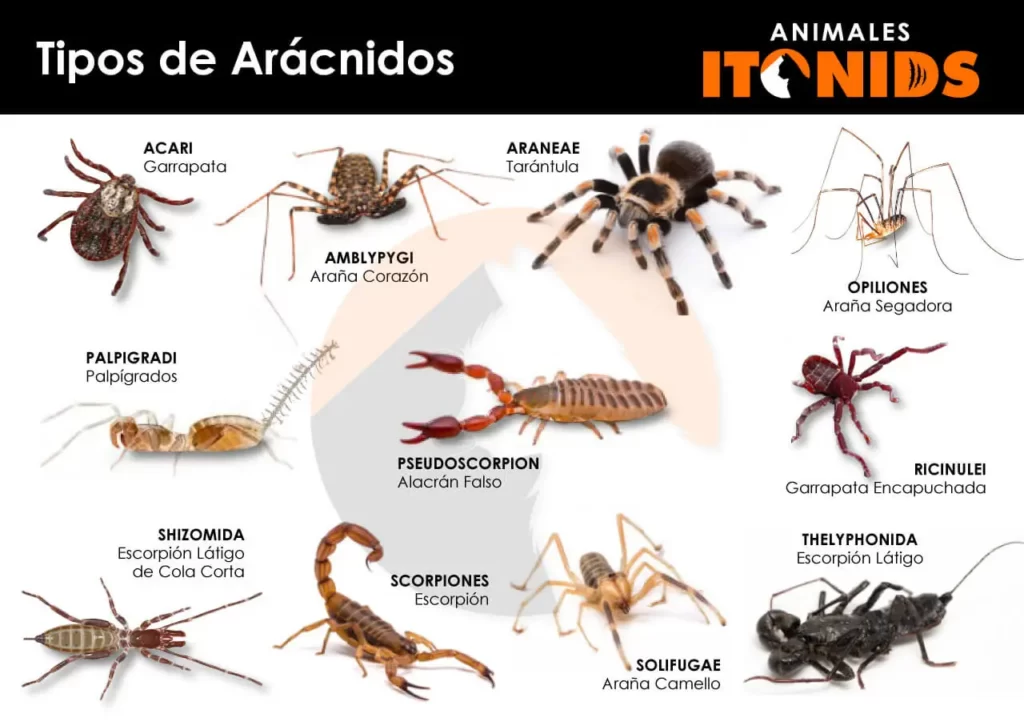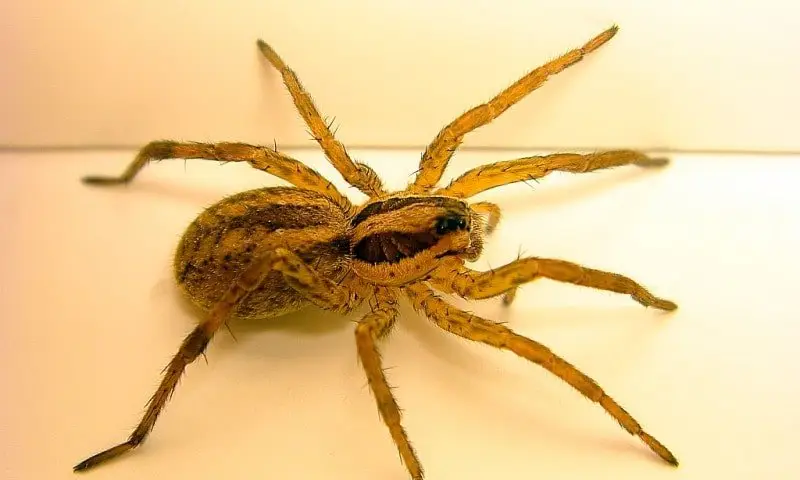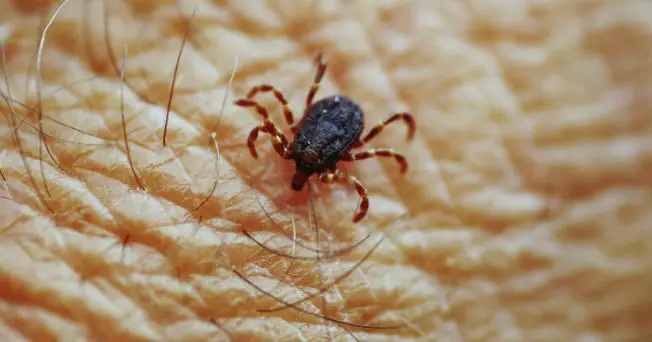Every species on our planet is unique in some aspect, and when it comes to exotic animals, the types of arachnids that exist (spiders, scorpions, ticks, harvestmen, mites, etc.) take a big prize.
They come from a large group of invertebrate animals called Arthropods, and generally, upon seeing them, they provoke sensations that range from fear to awe.
Surely in some corner of your home, when visiting a mountain trail, the desert, or even on your pet’s body, you have seen a specimen of this class (called Arachnida).
Do you want to know all about arachnid arthropods? Scientists describe more than 100,000 species of arachnids! With incredible peculiarities.
Get ready to explore the main characteristics of arachnids, with interesting data such as where they breathe, what they feed on, how they are classified, and which are the most outstanding arachnids.
You will be amazed!
Characteristics of Arachnids
They are part of the Animal Kingdom, Phylum or group Arthropoda (Arthropods), Subphylum Chelicerata (Chelicerates), and Class Arachnida (Arachnids).
Arthropods, for having jointed legs; Chelicerates, because they lack antennas and for the pincer shape of their mouthparts (called chelicerae), and Arachnida, in honor of the predominant species or animal: spider.
Where do Arachnids Live?
Despite their aquatic origin, current arachnid species are exclusively terrestrial arthropods, except for some mites, which have adapted to aquatic life.
They are located in all terrestrial climates, from tropical forests to the most remote deserts, excluding the extreme polar zones (Antarctica),
So you will see arachnids anywhere, your room, under the leaves, stones, in tree trunks… displaying (as in the case of spiders) impressive weaving patterns.

How is Their Body Formed?
Externally
Arachnids have an exoskeleton, meaning their skeleton is located on the outside and is made of a very resistant material (chitin), which covers and protects the internal and fleshy part (called endosternite).
Their body is divided into two parts: The Cephalothorax (also known as prosoma), formed by the union of the head and thorax into a single piece, and the Abdomen (opisthosoma).
The function of the cephalothorax is sensory and motor; it contains the central nervous system and the ocelli (eyes), as well as 4 mouth appendages in the form of hooks or pincers (called chelicerae and pedipalps) and 8 inserted legs.
The function of the abdomen is mainly reproductive; it contains the gonads (glands that generate sex hormones), which can be single or pairs, and the viscera (internal organs).
They do not have wings or antennas.
They do not have a compound visual organ, their eyes (ocelli) are simple but very efficient, allowing them to perceive light, but without differentiating defined shapes, and depending on the species, they can vary from zero (dust mite) to 2, 4, 6, and 8 eyes, always in even numbers.
Internally
They have a brain, located in the cephalothorax, formed by a mass of nerve ganglia (very small structures); mainly developing their sense of touch and hearing.
Their circulation is open; instead of a heart, there are blood vessels that act as pumps to drive blood throughout the body and transport oxygen, using a protein called hemocyanin, which contains copper, and gives the blood a blue color!
Their digestive system is made up of three regions: two external (stomodeum and proctodeum), and one internal (mesodeum).
The stomodeum contains the pharynx, esophagus, and stomach, and is responsible for pumping and sucking food; the mesodeum (or middle intestine) is where enzymes (digestive juices) are produced, and the proctodeum (short intestine and anus), is where they excrete (eliminate) waste.
Their growth occurs through molts, a process by which the arachnid releases a substance that dissolves the inner layer of the exoskeleton to form a new one.
Some have venomous glands.
Where do Arachnids Breathe?
Through aerial respiratory organs called book lungs or tracheae.
As they cannot directly inhale air, they contain in their abdomen a small bag, formed by folded tubes (tracheae), similar to the pages of a half-open book, hence their name.
These book lungs can vary between one (spiders) to four pairs (scorpions), depending on the species.
In the case of mites, the respiratory process occurs through special orifices called stigmata, directly connected to the trachea; and harvestmen do it through a tracheal system (set of tracheae) throughout their body.
How do they reproduce?
The fertilization process of arachnids occurs through spermatophores, small sacs containing sperm.
They are unisexual (only produce gametes of one sex) and depending on the species, the sperm is introduced into the female (through a genital orifice) in different ways:
Directly by the male (harvestmen, mites), through a copulatory organ; collected by the female from the place prepared as a deposit by the male (scorpions), or through modified pedipalps for this purpose (spiders).
After being fertilized, the female can lay eggs (oviparous), give birth to live young (viviparous), as is the case with scorpions, or be ovoviviparous (the egg is inside the mother), and the development is direct, that is, the offspring is born looking similar to the adult.
What do arachnids eat?
Most are carnivorous and feed on insects and other arachnids, such as the case of the scorpion, which can eat its own offspring; mites commonly feed on organic material (detritivores), and ticks are hematophagous (feed on blood).
As they do not have jaws, when capturing their prey, arachnids release a digestive juice on it, through their appendages, turning it into a pulp, easy to absorb through the pharynx.
Exceptions like the dust mite and harvestmen are capable of consuming solid particles, and large species, such as the tarantula spider, are capable of attacking and eating toads, birds…
In general, their diet maintains balance and control in insect populations.
And their behavior?
Arachnids are zoophagous, fierce, and solitary animals.
However, certain research indicates that in the Amazon rainforests of Peru, there are spiders that live in society, suspended in large webs in the shape of arches, and it is possible to find, in some arachnid families, a certain degree of sociability.
(If you want to read more about the study, you can visit: The strange social spiders of the Amazon that live in creepy communities of 50,000)
Regarding courtship, the male displays a tactic that involves sensory stimulation to attract the female and, at the same time, survival, as he runs the risk of being devoured… Dances, glances, emission of sounds, cleaning of the place, are part of the ceremony.
A very striking example is that of the spider Corythalia xantopoda; because if its eyes are painted black, there will be no reaction at all to the male’s display, so his effort will have been in vain.
Another example is the courtship carried out by the scorpion, with vibratory movements that invite the female to dance mutually held by the pedipalps; if she is attracted, he will lead her until she is positioned where he has left the spermatophore.

Classification of Arachnids
Eleven orders make up the Arachnid class:
- Acari (mites and ticks)
- Amblypygi (whip spiders)
- Araneae (spiders)
- Opiliones (harvestmen)
- Palpigradi (microwhip scorpions)
- Pseudoscorpionida (false scorpions)
- Ricinulei (hooded ticks or ricinuleids)
- Schizomida (mini vinegaroons or short-tailed whip scorpions)
- Scorpiones (scorpions)
- Solifugae (camel spiders)
- Thelyphonida or Uropygi (vinegaroons or whip scorpions)
Among the most common names of arachnids are: Spiders (order Araneae), scorpions (order Scorpiones), mites and ticks (order Acari), and harvestmen (order Opiliones).
Here are the particularities and examples of the most notable types of arachnids.
Spiders
They abound in the world, from coastal areas to the tops of mountains, and comprise more than 40,000 known species, distributed in 129 families; they live close to one year, and their main characteristic is a small cylinder called a pedicel or petiole, which separates both parts of their body.
The chelicerae, sharp and pointed, are connected to glands capable of secreting venom and paralyzing their prey; certain species have neurotoxic venoms that can be fatal. The male tends to be smaller and has different color markings.
Generally, they have 6 to 8 eyes, and although they produce silk, in liquid form, thicker than water, through glands located at the posterior end of the abdomen, not all spin webs; most are dedicated to hunting insects, camouflaging themselves to attack their prey.
Those that do, are characterized by spinning very subtle webs, used to capture food, lay their eggs, mate… The younger ones use the web as a parachute in the spring, letting themselves be carried by the wind.
Examples of these arachnids include: black widow, wolf spider, garden spider, crab spider, bald-legged spider, tarantula, tiger spider, hobo spider, violin spider, Brazilian wandering spider, golden orb-weaver, redback spider, camel spider, Tegenaria spider, mangora spider, corner spider, rainbow spider, velvet spider…
How many legs does a spider have?
A recurring question, and believe it or not, very useful to distinguish it from an insect; all spiders have 8 legs, unlike insects, which have 6.
Studies reveal that most spiders are capable of regenerating a lost leg, and not only that, but also appendages, as long as they have at least one molt left in their life cycle.
Scorpions
Scorpions inhabit all continents except Antarctica, with about 2000 species organized into 13 families.
They are characterized by large and strong front claws (chelated pedipalps) and a segmented, long tail arched over their body, which they always keep raised, ready to sting their victim with their deadly stinger or venomous claw (telson).
The variety of colors they exhibit and their different sizes allow them to camouflage (disguise) themselves with the environment they inhabit, hunting at night and remaining hidden during the day.
All have venom, but only 25 species are considered deadly. When they sting, they inject toxins capable of paralyzing muscles, causing intense pain, affecting breathing, causing heart alterations, and in some cases, death.
They can have between 6 and 12 eyes, distributed frontally (a pair) and laterally (two to five pairs). One of the great abilities of this animal is the capacity to survive without food or water for up to a year! Quite a feat.
Some examples of these arachnids are: the black-tailed scorpion, emperor, common yellow, Buenos Aires, Argentine, golden, thick-tailed, bark-striped, albino…
Is there any difference between a scorpion and an alacrán?
No. It is the same animal, only some classify them according to the region where they live, identifying each name with the amount of venom they possess, but this is not true.
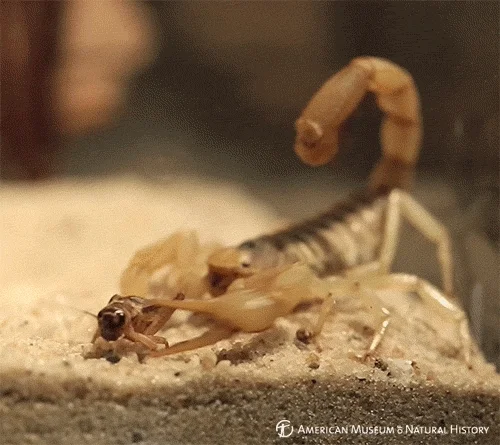
Mites and Ticks
This order encompasses about 50,000 species; they are found in terrestrial environments, commonly in the countryside, attached to grass, leaves, rotting wood, and urban and domestic spaces (dust)… until they attach to a mammalian host.
Some species can be found in aquatic environments.
The mite has an oval, translucent, and very small body (between 0.1 and 10 mm), so they often go unnoticed; the tick has a prominent head and a flat body, but takes a globular shape when it has absorbed a large amount of blood.
Certain species are transmitters of diseases to humans and animals and cause damage to crops and ornamental plants. Mite feces are responsible for allergic processes in humans (allergens).
Examples of these arachnids include: common or dust mite, tick, bird louse, red spider, cheese mite, scabies mite, soil mite, mange mite…
How to know if there are mites in my bed?
Where there is dust, there will undoubtedly be mites. Some of the signs that denote their presence are skin irritation, cough, intensification of allergic processes, itching… To avoid them, try to keep the space clean and ventilated, change sheets and covers regularly, and use anti-mite products.
Opiliones
There are about 6500 known species, distributed in 47 families; they prefer humid, shady places, and are predominant in tropical zones.
They are characterized by their long legs relative to their body, so they are sometimes confused with spiders and are given names like daddy longlegs, murgaños, or harvestmen; their body is not differentiated into two parts but appears as a whole, in a globular form.
They have a pair of simple eyes, and their body is very flexible; they do not spin webs, as they do not have silk-producing glands.
They lack venom but are capable of producing a repellent secretion, composed of chemical substances that produce an unpleasant smell (phenols), thanks to the existence of a pair of glands in the cephalothorax, spraying themselves or projecting a jet at their attacker.
In addition, they can camouflage themselves, play dead, and even mutilate one of their legs to distract their predator.
Examples of these arachnids include: Ogovea cameroonensis, Leiobunum politum, Sabacon cavicolens, Fumontana deprehendor…
What does Opiliones mean?
This curious name comes from the Latin “opilio,” which means “shepherd of sheep,” and represents


